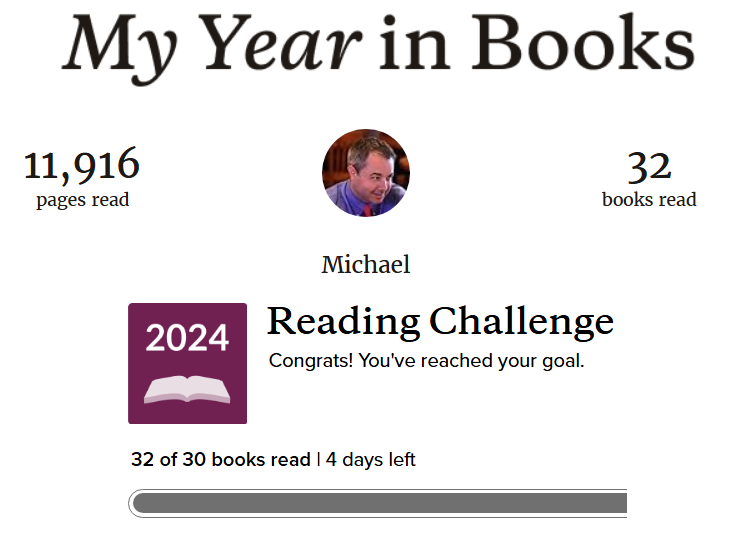I like to read. Having a Kindle makes it easy to take a book anywhere and with Libby, I can check them out easily from the library.
Since I read electronically, it’s easy to update Goodreads. Goodreads has a yearly challenge where you set a number of books to read and it helps track it.
This year, I set my target for 30 books and exceeded that goal with 32 read.

At the bottom, I’ll add the list of all the books that I read this year.
Here are the 3 books I found most interesting. They may not be the most well written, but they are the ones I enjoyed the most and think about.
Ra by qntm
The author, qntm, is also known for the slightly more discussed novel, There Is No Antimemetics Division, but I found Ra fascinating. Bringing us a world of magic as engineering in the beginning, the book makes a complete flip in the middle and creates yet another intriguing world. I wish there was a sequel, but unlikely given how the novel ends.
The Sword of Kaigen by M.L. Wang
I heard about The Sword of Kaigen on #booktok with huge amounts of praise. All of the acclaim is true. An alternate reality of an alternate Asian world filled with war, elemental magic, and family drama that keeps you sucked into the world built by M. L. Wang. It’s one of those books that’s hard to put down when it’s time to go to sleep.
Dark Wire by Joseph Cox
Joseph Cox is one of the founders of 404media, an investigative journalism site that does great work. His work on Dark Web subjects led him into the story of how the FBI got in the business of running an encrypted mobile phone company to spy on the secrets of criminal gangs on a global scale. Well written and detailed, the story is catnip to hacker types, both old and new. In addition to detailing the story of Anom phones, he also discusses the scale and scope of the illegal drug trade that operates a billion dollar economy hidden from public view.
All three of these books have my highest recommendation.
My honorable mention goes to A Wizard’s Guide to Defensive Baking by T. Kingfisher. If you are into the cozy fantasy genre, this book is a delight. Relaxing and fun, it’s a perfect book to escape the chaos of the real world.
My 2024 year in books (reverse chronological order)
The Pillars of the Earth by Ken Follett
Siddhartha by Hermann Hesse
Cursed Cocktails by S.L. Rowland
Alien Clay by Adrian Tchaikovsky
Saevus Corax Deals with the Dead by K.J. Parker
A Wizard’s Guide to Defensive Baking by T. Kingfisher
A Man Without a Country by Kurt Vonnegut Jr.
Path to Villainy: An NPC Kobold’s Tale by S.L. Rowland
System Collapse by Martha Wells
The Book of Doors by Gareth Brown
Moon Over Soho by Ben Aaronovitch
Starter Villain by John Scalzi
The Things We Make by Bill Hammack
Dark Wire by Joseph Cox
Emily Wilde’s Encyclopaedia of Faeries by Heather Fawcett
Service Model by Adrian Tchaikovsky
Ra by qntm
Arriving Today: From Factory to Front Door by Christopher Mims
Built: The Hidden Stories Behind Our Structures by Roma Agrawal
The Sword of Kaigen by M.L. Wang
Rivers of London by Ben Aaronovitch
Mickey7 by Edward Ashton
The Jinn-Bot of Shantiport by Samit Basu
Translation State by Ann Leckie
Ironclads by Adrian Tchaikovsky
Revelation Space by Alastair Reynolds
A Darker Shade of Magic by Victoria E. Schwab
The Blacktongue Thief by Christopher Buehlman
Quantum Radio by A.G. Riddle
Where the God-Knives Tread by A.L. Goldfuss
To Shape a Dragon’s Breath by Moniquill Blackgoose
A City on Mars by Kelly Weinersmith




























